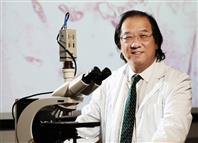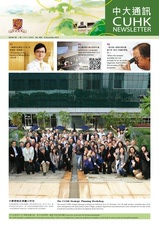Pathology is not a medical specialty that’s commonly known to the public. What is it about?
Pathology is concerned with examining blood, urine and cells samples, etc., extracted from patients to determine etiology and morphologic changes in order to facilitate diagnosis and treatment. In developed countries and Hong Kong, medical graduates have to undergo training for five to six years and pass professional examinations before they can become pathologists. Microscopes are the best partners of pathologists who spend over half of their time looking at specimens through the lens.
Why did you give up being a clinical physician and study pathology?
It’s just a coincidence. I was in the MB ChB programme at Edinburgh University where I met an inspiring pathologic mentor. Upon my graduation, I turned to pathology in my career. Clinical physicians work on the frontline and have face-to-face contact with patients. However, they have to handle other businesses too, including taking care of the emotions of care-givers. Being a pathologist gives me more flexibility in time management as I seek answers and solutions quietly behind the scenes. That said, both jobs aim at curing patients and they are equally challenging.
What gives a pathologist the biggest headache?
When the samples available are not enough for an accurate diagnosis. That’ll affect the accuracy of the prognosis. For instance, when a tumour lies deep in the body or in a critical area, only a small amount of tissues can be extracted. In this case, pathologists have to be very careful when examining and have to obtain the opinion from peers before drawing a conclusion.
What does it take to be a good pathologist?
Besides patience, attention to detail and being observant, a good pathologist should think from different perspectives when trying to seek the causes of diseases and predict pathological changes. It’s better if the pathologist has a sharp eye for colour changes, because the subtle discrepancies of colour in the specimens could be the result of important changes in the form and structure or in functional metabolism.
What gave you the idea for launching the Summer School for Pathologists from China in 1996?
I began academic exchange with pathologic circles on the mainland in the 1990s. I soon found out that due to financial or resource limitations, neither the equipment and reference materials nor systemic specialist training were adequate. This made accurate diagnoses difficult. In order to improve the overall standard of pathology in China, I obtained extra funding to set up the school. Mainland doctors of general practitioner rank or above were invited to CUHK to receive clinical diagnostic training from three months to a year. Some of them even participated in clinical diagnoses.
How is pathologist training for mainland China coming along?
The summer school programme was held for three years, benefitting over 300 mainland pathologists. After that, in 1999, 40 chairmen of pathology associations or departments of major institutions and myself came together to form the Association of Directors of Pathology of China. I was elected as the chairman. The aim of the association is to bring pathologic knowledge and technology to China. Academic conferences on related topics are organized from time to time and the ninth annual conference will be held next year. Throughout these years, the pathology standard of China has improved significantly. Being the vice-chairman of the International Academy of Pathology and the chairman of its education committee, I’ve switched my focus to underdeveloped neighbouring countries such as Indonesia and the Philippines in the past few years. Recently, I went to Cambodia to explore how I could lend my expertise.
What do you do in your spare time?
I like world history and am interested in how the past shapes the present. Thus, whenever I visit a new place, whether for business or leisure, I like to read up on its history beforehand. 


































































































































































Social Bookmarks